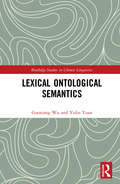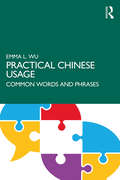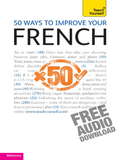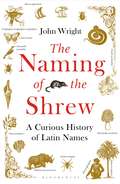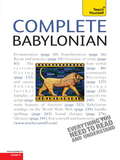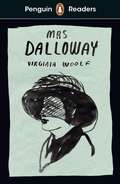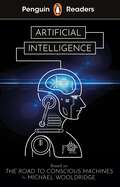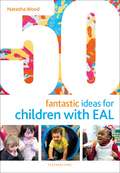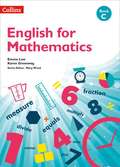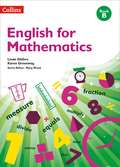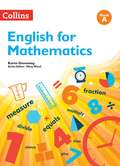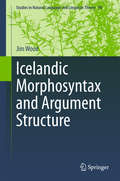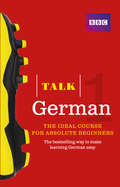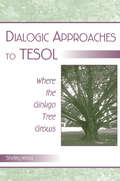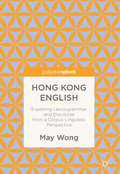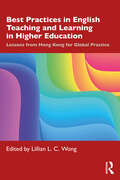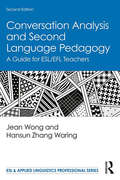- Table View
- List View
Intensification and Modal Necessity in Mandarin Chinese (Routledge Studies in Chinese Linguistics)
by Jiun-Shiung WuThis book addresses intensification and modal necessity in Mandarin Chinese. Intensification is used in this book to describe the speaker’s emphasis on a proposition, because, by emphasizing on a proposition, the speaker intensifies the degree of his/her confidence and affirmativeness toward the truth of a proposition, cf. the distinction between ‘weaker’ and ‘stronger’. Modal necessity discussed in this book refers either to the speaker’s certainty regarding the truth of an inference, judgment or stipulation, that is, epistemic necessity or to the speaker’s certainty concerning the obligatoriness of a proposition, based on rules or regulations, i.e., deontic necessity. This book examines a series of lexical items in Mandarin Chinese that express either intensification or modal necessity, provides a unified semantics and also presents how these lexical items are semantically distinct. Intensification and Modal Necessity in Mandarin Chinese is aimed at instructors, researchers and post-graduate students of Chinese Linguistics.
Intensification and Modal Necessity in Mandarin Chinese (Routledge Studies in Chinese Linguistics)
by Jiun-Shiung WuThis book addresses intensification and modal necessity in Mandarin Chinese. Intensification is used in this book to describe the speaker’s emphasis on a proposition, because, by emphasizing on a proposition, the speaker intensifies the degree of his/her confidence and affirmativeness toward the truth of a proposition, cf. the distinction between ‘weaker’ and ‘stronger’. Modal necessity discussed in this book refers either to the speaker’s certainty regarding the truth of an inference, judgment or stipulation, that is, epistemic necessity or to the speaker’s certainty concerning the obligatoriness of a proposition, based on rules or regulations, i.e., deontic necessity. This book examines a series of lexical items in Mandarin Chinese that express either intensification or modal necessity, provides a unified semantics and also presents how these lexical items are semantically distinct. Intensification and Modal Necessity in Mandarin Chinese is aimed at instructors, researchers and post-graduate students of Chinese Linguistics.
Lexical Ontological Semantics (Routledge Studies in Chinese Linguistics)
by Guoxiang Wu Yulin YuanLexical Ontological Semantics introduces ontological methods into lexical semantic studies with the aim of giving impetus to various fields of endeavours which envision and model the semantic network of a language. Lexical ontological semantics (LOS) provides a cognition-based computation-oriented framework in which nouns and predicates are described in terms of their semantic knowledge and models the mechanism in which the noun system is coupled with the predicate system. It expands the scope of lexical semantics, updates methodologies to semantic representation, guides the construction of semantic resources for natural language processing, and develops new theories for human-machine interactions and communications.
Lexical Ontological Semantics (Routledge Studies in Chinese Linguistics)
by Guoxiang Wu Yulin YuanLexical Ontological Semantics introduces ontological methods into lexical semantic studies with the aim of giving impetus to various fields of endeavours which envision and model the semantic network of a language. Lexical ontological semantics (LOS) provides a cognition-based computation-oriented framework in which nouns and predicates are described in terms of their semantic knowledge and models the mechanism in which the noun system is coupled with the predicate system. It expands the scope of lexical semantics, updates methodologies to semantic representation, guides the construction of semantic resources for natural language processing, and develops new theories for human-machine interactions and communications.
Practical Chinese Usage: Common Words and Phrases
by Emma L. WuPractical Chinese Usage offers post-beginner to near advanced students of Chinese a guide to the most frequently misused and confusing words in the language. Entries are arranged in alphabetical order for ease of reference. Sample sentences with pinyin and English translations are provided after each explanation. Examples of typical mistakes made by students are clearly marked throughou. Each entry is annotated in accordance with the New HSK guidelines, indicating the level of difficulty. Practical Chinese Usage provides students of Chinese with the necessary tools to refine their use of expressions and synonyms in order to communicate effectively in the Chinese language.
50 Ways to Improve your French: 50 Ways To Improve Your French (Teach Yourself)
by Lorna Wright Marie-Jo MorelleDo you have a working knowledge of French, but want to improve? Allow this book to come to your rescue and eliminate basic errors and slips of the pen. Each one of 50 top tips for improving your spoken and written French is presented and analysed across a whole double page, with explanations as to where and why people sometimes go wrong. The tips are grouped into grammar, spelling, false friends, pronunciation and cultural faux pas sections. There's even free downloadable audio content available to help you with your pronunciation. Polish your French with this brand new series from Teach Yourself - the No. 1 brand in language learning. 50 ways to improve your French touches all essential bases and is divided into the following easily digestible sections:Only got a minute?A 60-second introduction to French to get you started.Only got five minutes?Get to grips with French and its common pitfalls even if you're short of time.Only got ten minutes?Use your free time wisely to learn something about the French language. InsightsInstant help with common problems and quick tips for success, based on Lorna Wright and Marie-Jo Morelle's many years of experience.Test yourselfTests online to keep track of your progress. ArticlesExtra information to keep you motivated.SummariesQuick refreshers to help you remember the key facts.GrammarEasy-to-follow building blocks to give you a clear understanding.PronunciationDon't sound like a tourist - polish your pronunciation before you go.Audio Downloadable audio support online to help with key areas - iPod/MP3 compatibleFor your free audio download please visit: www.hodder.co.uk/TYLfreedownloads
The Naming of the Shrew: A Curious History of Latin Names
by John WrightLatin names – frequently unpronounceable, all too often wrong and always a tiny puzzle to unravel – have been annoying the layman since they first became formalised as scientific terms in the eighteenth century. Why on earth has the entirely land-loving Eastern Mole been named Scalopus aquaticus, or the Oxford Ragwort been called Senecio squalidus – 'dirty old man'? What were naturalists thinking when they called a beetle Agra katewinsletae, a genus of fish Batman, and a Trilobite Han solo? Why is zoology replete with names such as Chloris chloris chloris (the greenfinch), and Gorilla gorilla gorilla (a species of, well gorilla)?The Naming of the Shrew will unveil these mysteries, exploring the history, celebrating their poetic nature and revealing how naturalists sometimes get things so terribly wrong. With wonderfully witty style and captivating narrative, this book will make you see Latin names in a whole new light.
Complete Babylonian: A Comprehensive Guide to Reading and Understanding Babylonian, with Original Texts (Complete Languages)
by Martin WorthingtonDo you want to engage with Babylonian culture and literature in the original language?The course will introduce you to a fascinating world of gods and demons, heroes and kings.The readings are drawn from myths, letters, law-codes, medical incantations, and other authentic, ancient writings. The language is presented in the Roman alphabet, with an explanation of cuneiform script, and the main features of Assyrian - cognate with Babylonian - are also explained.Learn effortlessly with a new easy-to-read page design and interactive features in this book from Teach Yourself, the No. 1 brand in language learning.
Penguin Readers Level 7: Mrs Dalloway (ELT Graded Reader)
by Virginia WoolfPenguin Readers is an ELT graded reader series for learners of English as a foreign language. With carefully adapted text, new illustrations and language learning exercises, the print edition also includes instructions to access supporting material online.Titles include popular classics, exciting contemporary fiction, and thought-provoking non-fiction, introducing language learners to bestselling authors and compelling content.The eight levels of Penguin Readers follow the Common European Framework of Reference for language learning (CEFR). Exercises at the back of each Reader help language learners to practise grammar, vocabulary, and key exam skills. Before, during and after-reading questions test readers' story comprehension and develop vocabulary.Mrs Dalloway, a Level 7 Reader, is B2 in the CEFR framework. The longer text is made up of sentences with up to four clauses, introducing future perfect simple, mixed conditionals, past perfect continuous, mixed conditionals, more complex passive forms and modals for deduction in the past.On a June morning in 1923, Clarissa Dalloway is preparing for a party she is giving that evening. As she walks through London, her thoughts are of the past and her choice of husband. At the same time, and also in London, Septimus Smith is being driven mad by shell shock. At the party that evening, their stories come together.Visit the Penguin Readers websiteExclusively with the print edition, readers can unlock online resources including a digital book, audio edition, lesson plans and answer keys.
Penguin Readers Level 7: Artificial Intelligence (ELT Graded Reader)
by Michael WooldridgePenguin Readers is an ELT graded reader series. Please note that the eBook edition does NOT include access to the audio edition and digital book. Written for learners of English as a foreign language, each title includes carefully adapted text, new illustrations and language learning exercises.Titles include popular classics, exciting contemporary fiction, and thought-provoking non-fiction, introducing language learners to bestselling authors and compelling content.The eight levels of Penguin Readers follow the Common European Framework of Reference for language learning (CEFR). Exercises at the back of each Reader help language learners to practise grammar, vocabulary, and key exam skills. Before, during and after-reading questions test readers' story comprehension and develop vocabulary.Artificial Intelligence, a Level 7 Reader, is B2 in the CEFR framework. The longer text is made up of sentences with up to four clauses, introducing future perfect simple, mixed conditionals, past perfect continuous, mixed conditionals, more complex passive forms and modals for deduction in the past.This book aims to explain what AI is and what it is not. It turns to different subjects to understand AI, and what it means for the world. It also examines important AI developments in the past, present and future.Visit the Penguin Readers websiteRegister to access online resources including tests, worksheets and answer keys. Exclusively with the print edition, readers can unlock a digital book and audio edition (not available with the eBook).
Introducing Researching English for Specific Purposes (Routledge Introductions to English for Specific Purposes)
by Lindy WoodrowIntroducing Researching English for Specific Purposes is an accessible and practical guide to research in ESP. It’s for novice researchers, graduate students and for ESP practitioners who want to do some research themselves. The author takes the reader step by step through the stages of research, starting with choosing a topic and reviewing the literature though to writing up research findings. Examples are taken from academic journals and dissertations to highlight aspects of the research process. The book covers the following areas: developing a research project research design theoretical approaches to ESP research choosing a research topic quantitative, qualitative and mixed methods in ESP research validity, reliability and ethics writing up research in ESP The book includes recommendations for further reading and tasks. There is also a glossary and a chapter providing advice, templates and links to useful research sources. Introducing Researching English for Specific Purposes is essential reading for anyone wanting to conduct research in ESP.
Introducing Researching English for Specific Purposes (Routledge Introductions to English for Specific Purposes)
by Lindy WoodrowIntroducing Researching English for Specific Purposes is an accessible and practical guide to research in ESP. It’s for novice researchers, graduate students and for ESP practitioners who want to do some research themselves. The author takes the reader step by step through the stages of research, starting with choosing a topic and reviewing the literature though to writing up research findings. Examples are taken from academic journals and dissertations to highlight aspects of the research process. The book covers the following areas: developing a research project research design theoretical approaches to ESP research choosing a research topic quantitative, qualitative and mixed methods in ESP research validity, reliability and ethics writing up research in ESP The book includes recommendations for further reading and tasks. There is also a glossary and a chapter providing advice, templates and links to useful research sources. Introducing Researching English for Specific Purposes is essential reading for anyone wanting to conduct research in ESP.
50 Fantastic Ideas for Children with EAL (50 Fantastic Ideas)
by Natasha WoodEvery year, an increasing number of children enter the Early Years setting either new to English or with English as an additional language (EAL), which can be daunting, not just for the child but for the practitioner too. How can Early Years practitioners ensure that the right support is in place for the child and themselves? What practical ideas can be used successfully to enrich an EAL child's understanding of a new language, while, at the same time, allowing that child to bond with their peers? 50 Fantastic Ideas for Children with EAL is an invaluable resource to help integrate children with EAL into the classroom with fresh, exciting and engaging activities that are easy to resource, require little preparation and are fun to carry out. The activities include simple speak-and-repeat games, visual ideas to support learning new words and phrases and activities that evoke feelings of being at home, allowing the children to feel welcomed and part of the school's diverse community. Traditional games are also featured to help children with EAL play with their peers, as well as feel that they can contribute to the learning of others. Perfect for promoting inclusion and self-esteem, 50 Fantastic Ideas for Children with EAL is ideal for supporting children as they navigate the ups and downs of having English as an additional language.
English For Mathematics: Book C (PDF)
by Mary Wood Emma Low Karen GreenwaySupport young learners learning Mathematics in English. This workbook provides support for 9- to 10-year-old children who are learning mathematics in English. It teaches young learners the vocabulary and language they need in their mathematics classes.
English For Mathematics: Book B (PDF)
by Mary Wood Karen Greenway Linda GlithroSupport young learners learning Mathematics in English. This workbook provides support for 8- to 9-year-old children who are learning mathematics in English. It teaches young learners the vocabulary and language they need in their mathematics classes.
English For Mathematics: Book A (PDF)
by Mary Wood Karen GreenwaySupport young learners learning Mathematics in English. This workbook provides support for 7- to 8-year-old children who are learning mathematics in English. It teaches young learners the vocabulary and language they need in their mathematics classes.
Icelandic Morphosyntax and Argument Structure (Studies in Natural Language and Linguistic Theory #90)
by Jim WoodThis book provides a detailed study of Icelandic argument structure alternations within a syntactic theory of argument structure. Building on recent theorizing within the Minimalist Program and Distributed Morphology, the author proposes that much of what is traditionally attributed to syntax should be relegated to the interfaces, and adapts the late insertion theory of morphology to semantics. The resulting system forms sound-meaning pairs by generating hierarchical structures that can be translated into morphological representations, on the one hand, and semantic representations, on the other. The syntactic primitives, however, underdetermine both morphophonology and semantics. Without appealing to special stipulations, the theory derives constraints on the external argument of causative-alternation verbs, interpretive restrictions on nominative objects, and the optionally agentive interpretation of verbs denoting self-directed motion.
Talk German Enhanced eBook (with audio) - Learn German with BBC Active: The bestselling way to make learning German easy
by Jeanne Wood Judith Matthews‘Determined to learn the language but no time for nightschool? Try the BBC Talk short courses.’ The GuardianLearn even faster and smarter with the flexibility, speed and convenience of this enhanced eBook. Everything you need is just where you need it: navigate the book with ease, practise your listening and speaking skills, test your progress and access valuable language notes all with one touch from the page you’re on. Talk German has already inspired thousands of people to learn German from scratch and find the confidence to give it a go. It is a bestselling course, widely used both in the classroom and by independent learners. Make fast progress right from the start using the successful, proven Talk method - with specially designed activities, interactive audio and clear, jargon-free grammar explanations. Develop your language skills with tips and strategies to help you learn. Express yourself more confidently through taking part in real German conversations. Whether you’re learning for business, travel or just for fun, this straightforward, step-by-step approach will ensure you’re soon able to speak German in a range of everyday situations.Want to improve your grammar? Get quickly up to speed with our bestselling Talk German Grammar eBook. Easy to follow and specially written to work with this course, it’ll help you easily demystify and unlock the key structures of German grammar and boost your understanding, speaking and listening skills. Search now for ‘Talk German Grammar’. Learner reviews of the book/CD version of Talk German:‘Exactly what I needed. Clear, easy to follow and useful language.’ ‘A must if you are serious about learning German. Very informative and easy to understand with numerous examples. This book certainly helps me to learn German properly rather than just learning simple phrases.’ ‘I think the BBC language courses are very good, got this one to support with my German class, as the Tutor uses the same course book.’ Also available: Talk Spanish Enhanced eBook, Talk French Enhanced eBook and Talk Italian Enhanced eBook; Talk Spanish Grammar eBook, Talk French Grammar eBook, Talk Italian Grammar eBook and Talk German Grammar eBook
Dialogic Approaches to TESOL: Where the Ginkgo Tree Grows
by Shelley WongThis book locates dialogic pedagogy within the history of TESOL approaches and methods in which the communicative approach has been the dominant paradigm. Dialogic inquiry in the form of story telling, oral histories, and knowledge from the ground up and from the margins has much to offer the field. In dialogic approaches, the teacher and students learn in community and the students' home languages and cultures, their families and communities, are seen as resources.Dialogic Approaches to TESOL: Where the Ginkgo Tree Grows explores teacher research, feminist contributions to voice, social identity and dialogic pedagogy, and the role of teachers, students, families, and communities as advocates and change agents. After a brief history of TESOL methods and an introduction to dialogic pedagogy, four features of dialogic approaches to TESOL are identified and discussed: learning in community, problem-posing, learning by doing, and who does knowledge serve? The main text in each chapter considers a single topic related to the concept of dialogic pedagogy. Branching text leads to related discussions without losing the main point of the chapter. This structure allows readers to become well-rooted in each component of dialogic pedagogy and to "branch out" into deeper philosophic understandings as well as actual practices across a range of contexts.Dialogic Approaches to TESOL offers a place for dialogue and reflection on the prospects for transforming educational institutions to serve those who have historically been excluded and marginalized. It provides questions, frameworks, and resources for those who are just beginning in the field and for U.S.-based educators who want to bring critical multicultural and multilingual perspectives into language arts, reading and literacy education.
Dialogic Approaches to TESOL: Where the Ginkgo Tree Grows
by Shelley WongThis book locates dialogic pedagogy within the history of TESOL approaches and methods in which the communicative approach has been the dominant paradigm. Dialogic inquiry in the form of story telling, oral histories, and knowledge from the ground up and from the margins has much to offer the field. In dialogic approaches, the teacher and students learn in community and the students' home languages and cultures, their families and communities, are seen as resources.Dialogic Approaches to TESOL: Where the Ginkgo Tree Grows explores teacher research, feminist contributions to voice, social identity and dialogic pedagogy, and the role of teachers, students, families, and communities as advocates and change agents. After a brief history of TESOL methods and an introduction to dialogic pedagogy, four features of dialogic approaches to TESOL are identified and discussed: learning in community, problem-posing, learning by doing, and who does knowledge serve? The main text in each chapter considers a single topic related to the concept of dialogic pedagogy. Branching text leads to related discussions without losing the main point of the chapter. This structure allows readers to become well-rooted in each component of dialogic pedagogy and to "branch out" into deeper philosophic understandings as well as actual practices across a range of contexts.Dialogic Approaches to TESOL offers a place for dialogue and reflection on the prospects for transforming educational institutions to serve those who have historically been excluded and marginalized. It provides questions, frameworks, and resources for those who are just beginning in the field and for U.S.-based educators who want to bring critical multicultural and multilingual perspectives into language arts, reading and literacy education.
Hong Kong English: Exploring Lexicogrammar and Discourse from a Corpus-Linguistic Perspective
by May WongThis book systematically examines the linguistic features and socio-cultural issues of ‘Hong Kong English’. The author focuses on authentic data taken from the International Corpus of English (the Hong Kong component) and the Corpus of Global Web-based English to track the ways in which the English language in Hong Kong has been adapted by its users. She also analyses the emergence of new forms and structures in its grammar and discourse. While the phonetic and phonological aspects of this variety of English have been well documented, its grammatical peculiarities and social language use have been hitherto neglected. This book offers original insights into the grammatical and pragmatic/discoursal features of Hong Kong English and will therefore be of interest to those working in fields such as World Englishes and corpus linguistics.
Best Practices in English Teaching and Learning in Higher Education: Lessons from Hong Kong for Global Practice
by Lillian L. C. WongLillian Wong brings together evidence- informed studies which are at the forefront of higher education developments in English language teaching and learning, and shares expertise from prominent academics in Hong Kong. Written by experienced practitioners who are active in the evolving field of scholarship of teaching and learning, it provides accessible and engaging insights into best practices in new and innovative areas, such as communities of practice, scholarship, big data analytics, digital literacies, blended learning, small private online courses, dialogic use of exemplars, students as tutors and critical thinking. The book covers best practices in three interrelated key areas in university English language education, including curriculum design and pedagogy, use of technologies and the teaching and learning of English in the disciplines. Linking theory and practice, the chapters discuss the emphasis on EAP/ ESP in university English language education, how technological developments are impacting the field and the implications for further research and the teaching of English in higher education. This resourceful collection is essential reading for teachers in- service and intraining, or those working in language education at the tertiary level where English is being used as an academic lingua franca, a medium of instruction or where EAP/ ESP plays an important role. Researchers in TESOL and applied linguistics, curriculum designers and leaders, teacher educators and policymakers as well as undergraduate and postgraduate students will also find it valuable.
Best Practices in English Teaching and Learning in Higher Education: Lessons from Hong Kong for Global Practice
by Wong, Lillian L. CLillian Wong brings together evidence- informed studies which are at the forefront of higher education developments in English language teaching and learning, and shares expertise from prominent academics in Hong Kong. Written by experienced practitioners who are active in the evolving field of scholarship of teaching and learning, it provides accessible and engaging insights into best practices in new and innovative areas, such as communities of practice, scholarship, big data analytics, digital literacies, blended learning, small private online courses, dialogic use of exemplars, students as tutors and critical thinking. The book covers best practices in three interrelated key areas in university English language education, including curriculum design and pedagogy, use of technologies and the teaching and learning of English in the disciplines. Linking theory and practice, the chapters discuss the emphasis on EAP/ ESP in university English language education, how technological developments are impacting the field and the implications for further research and the teaching of English in higher education. This resourceful collection is essential reading for teachers in- service and intraining, or those working in language education at the tertiary level where English is being used as an academic lingua franca, a medium of instruction or where EAP/ ESP plays an important role. Researchers in TESOL and applied linguistics, curriculum designers and leaders, teacher educators and policymakers as well as undergraduate and postgraduate students will also find it valuable.
Conversation Analysis and Second Language Pedagogy: A Guide for ESL/EFL Teachers (ESL & Applied Linguistics Professional Series)
by Jean Wong Hansun Zhang WaringNow in its second edition, this volume offers a strong synthesis of classic and current work in conversation analysis (CA), usefully encapsulated in a model of interactional practices that comprise interactional competence. Through this synthesis, Wong and Waring demonstrate how CA findings can help to increase language teachers’ awareness of the spoken language and suggest ways of applying that knowledge to teaching second language interaction skills. The Second Edition features: Substantial updates that include new findings on interactional practices Reconceptualized, reorganized, and revised content for greater accuracy, clarity, and readability Expanded key concepts glossary at the end of each chapter New tasks with more transcripts of actual talk New authors' stories The book is geared towards current and prospective second or foreign language teachers, material developers, and other language professionals, and assumes neither background knowledge of conversation analysis nor its connection to second language teaching. It also serves as a handy reference for those interested in key CA findings on social interaction.
Conversation Analysis and Second Language Pedagogy: A Guide for ESL/EFL Teachers (ESL & Applied Linguistics Professional Series)
by Jean Wong Hansun Zhang WaringNow in its second edition, this volume offers a strong synthesis of classic and current work in conversation analysis (CA), usefully encapsulated in a model of interactional practices that comprise interactional competence. Through this synthesis, Wong and Waring demonstrate how CA findings can help to increase language teachers’ awareness of the spoken language and suggest ways of applying that knowledge to teaching second language interaction skills. The Second Edition features: Substantial updates that include new findings on interactional practices Reconceptualized, reorganized, and revised content for greater accuracy, clarity, and readability Expanded key concepts glossary at the end of each chapter New tasks with more transcripts of actual talk New authors' stories The book is geared towards current and prospective second or foreign language teachers, material developers, and other language professionals, and assumes neither background knowledge of conversation analysis nor its connection to second language teaching. It also serves as a handy reference for those interested in key CA findings on social interaction.

